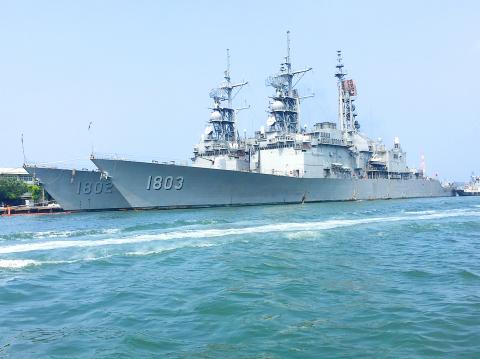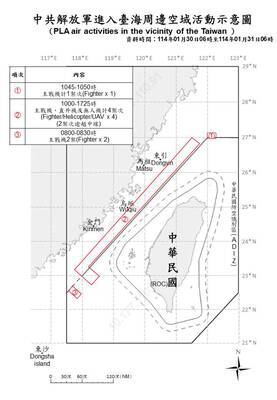The military is to upgrade the AN/SLQ-32 electronic warfare system on its four Keelung-class guided missile destroyers from the (V)3 variant to the (V)6 variant.
The upgrade, which is to cost a total of NT$1.99 billion (US$65.24 million), is expected to be completed by 2023, sources said.
It would improve the system’s electronic and mechanical countermeasure capabilities, and the vessels would be able to avoid threats more effectively, they said.

Photo: Huang Hsu-lei, Taipei Times
The upgrade would also improve the vessels’ survival rate and benefit defense operations, they added.
The (V)3 systems have been in use for 13 years, they said.
The US military has already upgraded to the (V)6 variant and has suggested that Taiwan do the same, the navy said on Saturday.
This year, the navy created the six-year budget after US President Donald Trump’s administration in June last year announced that it would sell AN/SLQ-32 upgrades to Taiwan.
Next year’s budget was reported to be about NT$66.19 million.
The upgrades are to be implemented based on a fixed maintenance schedule to accommodate the needs of defending the Taiwan Strait, sources said.
The Keelung-class guided missile destroyers were originally Kidd-class destroyers which served in the US Navy from 1981 to 1998.
The US agreed to sell them to Taiwan in 2001, and they have been part of the Republic of China Navy since 2005.
Unlike the Kang Ding-class and Cheng Kung-class frigates, which use missiles made in Taiwan, the Keelung-class destroyers use US-made Standard and Harpoon missiles.
The military is to also purchase 16 Standard Missile 2 (SM-2) Block IIIA surface-to-air missiles to bolster its air defense capabilities, a navy officer said on condition of anonymity.
Additional reporting by CNA

UNITED: The premier said Trump’s tariff comments provided a great opportunity for the private and public sectors to come together to maintain the nation’s chip advantage The government is considering ways to assist the nation’s semiconductor industry or hosting collaborative projects with the private sector after US President Donald Trump threatened to impose a 100 percent tariff on chips exported to the US, Premier Cho Jung-tai (卓榮泰) said yesterday. Trump on Monday told Republican members of the US Congress about plans to impose sweeping tariffs on semiconductors, steel, aluminum, copper and pharmaceuticals “in the very near future.” “It’s time for the United States to return to the system that made us richer and more powerful than ever before,” Trump said at the Republican Issues Conference in Miami, Florida. “They

GOLDEN OPPORTUNITY: Taiwan must capitalize on the shock waves DeepSeek has sent through US markets to show it is a tech partner of Washington, a researcher said China’s reported breakthrough in artificial intelligence (AI) would prompt the US to seek a stronger alliance with Taiwan and Japan to secure its technological superiority, a Taiwanese researcher said yesterday. The launch of low-cost AI model DeepSeek (深度求索) on Monday sent US tech stocks tumbling, with chipmaker Nvidia Corp losing 16 percent of its value and the NASDAQ falling 612.46 points, or 3.07 percent, to close at 19,341.84 points. On the same day, the Philadelphia Stock Exchange Semiconductor Sector index dropped 488.7 points, or 9.15 percent, to close at 4,853.24 points. The launch of the Chinese chatbot proves that a competitor can

TAIWAN DEFENSE: The initiative would involve integrating various systems in a fast-paced manner through the use of common software to obstruct a Chinese invasion The first tranche of the US Navy’s “Replicator” initiative aimed at obstructing a Chinese invasion of Taiwan would be ready by August, a US Naval Institute (USNI) News report on Tuesday said. The initiative is part of a larger defense strategy for Taiwan, and would involve launching thousands of uncrewed submarines, surface vessels and aerial vehicles around Taiwan to buy the nation and its partners time to assemble a response. The plan was first made public by the Washington Post in June last year, when it cited comments by US Indo-Pacific Commander Admiral Samuel Paparo on the sidelines of the Shangri-La Dialogue

MARITIME SECURITY: Of the 52 vessels, 15 were rated a ‘threat’ for various reasons, including the amount of time they spent loitering near subsea cables, the CGA said Taiwan has identified 52 “suspicious” Chinese-owned ships flying flags of convenience that require close monitoring if detected near the nation, the Coast Guard Administration (CGA) said yesterday, as the nation seeks to protect its subsea telecoms cables. The stricter regime comes after a Cameroon-flagged vessel was briefly detained by the CGA earlier this month on suspicion of damaging an international cable northeast of Taiwan. The vessel is owned by a Hong Kong-registered company with a Chinese address given for its only listed director, the CGA said previously. Taiwan fears China could sever its communication links as part of an attempt